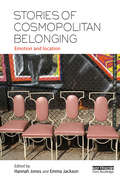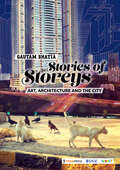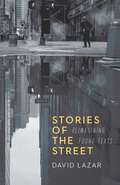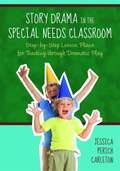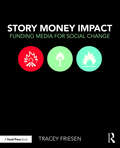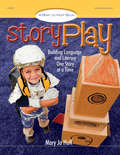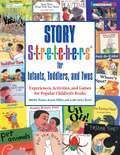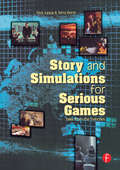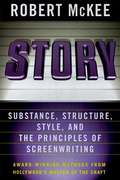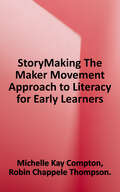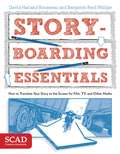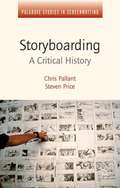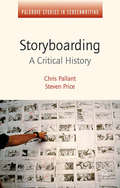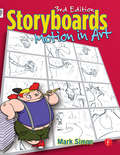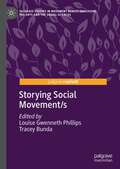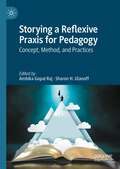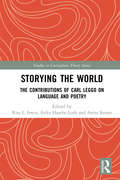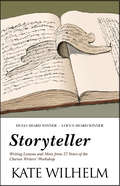- Table View
- List View
Stories of Cosmopolitan Belonging: Emotion and Location
by Emma Jackson Hannah JonesWhat does it mean to belong in a place, or more than one place? This exciting new volume brings together work from cutting-edge interdisciplinary scholars researching home, migration and belonging, using their original research to argue for greater attention to how feeling and emotion is deeply embedded in social structures and power relations. Stories of Cosmopolitan Belonging argues for a practical cosmopolitanism that recognises relations of power and struggle, and that struggles over place are often played out through emotional attachment. Taking the reader on a journey through research encounters spiralling out from the global city of London, through English suburbs and European cities to homes and lives in Jamaica, Puerto Rico and Mexico, the contributors show ways in which international and intercontinental migrations and connections criss-cross and constitute local places in each of their case studies. With a reflection on the practice of 'writing cities' from two leading urbanists and a focus throughout the volume on empirical work driving theoretical elaboration, this book will be essential reading for those interested in the politics of social science method, transnational urbanism, affective practices and new perspectives on power relations in neoliberal times. The international range of linked case studies presented here will be a valuable resource for students and scholars in sociology, anthropology, urban studies, cultural studies and contemporary history, and for urban policy makers interested in innovative perspectives on social relations and urban form.
Stories of Stairs (Fountas & Pinnell Classroom, Guided Reading Grade 3)
by Casey MaoNIMAC-sourced textbook
Stories of Storeys: Art, Architecture and the City
by Gautam BhatiaA renowned architect and artist on how public architecture in our cities has lost contact with the lives of the common people. Behind the seemingly ordinary life of a practising architect lies a whole host of non-professional impulses that give shape to buildings. Stories of Storeys: Art, Architecture and the City is about these impulses and conditions—social, literate, personal and political—which are expressed, but often ignored in architecture. Bhatia looks at the ordinary, physical, visible and tactile involvement of our urban environment and the way it affects, communicates with, or influences us. An all-inclusive sociology of architecture, the book draws on the social life of some of architecture’s role players, people whose peculiar demands on design have come to characterize the building environment of our times, and times that are characterized by this progressive isolation of architecture from the society of common people.
Stories of the Street: Reimagining Found Texts
by David LazarWhen walking down the street, it is not uncommon to see lost items that have escaped their proper receptacles, but how often does one stop to read the messages left behind? David Lazar has stopped often, capturing the pieces of a &“lost world on the streets&” and thinking about the life of the discarder from the fragments left behind.Stories of the Street is a series of imaginative meditations—through prose poems, short-short essays, microfictions, and prose pieces without precise genre distinction—of what it means to encounter lost or discarded texts. Rather than simply deconstructing the lists, notes, receipts, or book pages he finds strewn in various cities, Lazar uses them as suggestive, capable of inspiring possible narratives that are at most latent in the text itself. The encounter, then, is an encounter with oneself and the mysteries of cities, where detritus frequently doubles as a sign saying, &“Consider this.&” Lazar&’s narrative voice ranges in tone from the comically antic to the melancholy. By photographing what he describes as &“messages that had escaped their bottles&” on-location as found, Lazar has become a flaneur of paper debris, puzzling over the evidence of urban human life.
Stories: Screen Narrative in the Digital Era (The Key Debates: Mutations and Appropriations in European Film Studies)
by Ian Christie van den Oever, AnnieStories are perceived as central to modern life. Not only in narrative entertainment media, such as television, cinema, theater, but also in social media. Telling/having a story is widely deemed essential, in business as well as in social life. Does this mark an intensification of what has always been part of human cultures; or has the realm of story expanded to dominate twenty-first century discourse? Addressing stories is an obvious priority for the Key Debates series, and Volume 7, edited by Ian Christie and Annie van den Oever, identifies new phenomena in this field — complex narration, puzzle films, transmedia storytelling — as well as new approaches to understanding these, within narratology and bio-cultural studies. Chapters on such extended television series as Twin Peaks, Game of Thrones and Dickensian explore distinctively new forms of screen storytelling in the digital age. With contributions by Vincent Amiel, Jan Baetens, Dominique Chateau, Ian Christie, John Ellis, Miklós Kiss, Eric de Kuyper, Sandra Laugier, Luke McKernan, José Moure, Roger Odin, Annie van den Oever, Melanie Schiller, Steven Willemsen, Robert Ziegler.
Storm: Chasing Nature's Wildest Weather
by Hank SchymaA thrilling introduction to the world of storms, told in the unmistakable voice of Hank Schyma.Over three decades of storm chasing, Hank Schyma has witnessed some of planet Earth’s most incredible weather shows. STORM brings together the very best of his work, featuring dramatic photography, unforgettable stories from the road and clear, engaging explanations of the science behind the storms.Inside this book you’ll find:Thrilling stories from decades of chasing storms across the US and beyond, including behind-the-scenes accounts of record-breaking tornadoes and incredible lightning showsDetailed graphics and clear, accessible breakdowns of the science behind the spectacle, from how hurricanes form to what makes a tornado spinA collection of Hank’s out-of-this-world storm and nature photography, showcasing everything from epic lightning bolts to massive supercellsChapters covering thunderstorms, lightning, transient luminous events (TLEs), supercells, tornadoes, and tropical cyclonesWhether you’re a long-time fan of Hank’s or simply curious about what makes our weather so wild, STORM invites you into Hank’s world: a place of big skies, bigger energy, and a lifelong fascination with nature at its most extreme.Looking for the perfect photography book, nature book or weather book? STORM will astonish you with every page.
Story Based Selling
by Jeff BloomfieldAs a founder of a successful organization that trains and develops sales professionals, Jeff Bloomfield has given a lot of thought to why customers say yes. In Story-Based Selling: Create, Connect, and Close, Mr. Bloomfield says it's really no mystery. People buy from people they trust. They trust people they like, and they like people they connect to. And he believes that storytelling is the best way for salespeople-and all of us-to immediately connect to a customer's feelings of trust and liking. He thinks teaching sales professionals to close a deal by presenting their product, probing its mutual benefits, and overcoming the customer's objections and skepticism, is a waste of time. Instead, he urges them to tell a great story. Mr. Bloomfield calls upon the latest research in neuroscience to explain the process of communication. The truth is that during the salesperson's engagement with clients, people quickly base their decisions on how they feel, not the way they think, so trying to persuade someone by first imparting lifeless facts and figures is self-defeating. In fact, this information goes right to an area of the listener's brain (the left brain) that drives doubt and skepticism. To make a deal we need to connect with the parts of the customer's brain that inspire emotions of trust and empathy. By telling a story, we can immediately connect to these good gut feelings and drive away the client's fear of being sold. Mr. Bloomfield tells his own engaging stories while teaching step-by-step techniques of intentional storytelling-to create a fast connection with the listener, no matter who is buying or what a person wants to sell.
Story Land
by Jim MillerWhen sedans and station wagons replaced trains for vacationers heading to New Hampshire's rugged and picturesque White Mountains, new motels and attractions catering to middle-class families sprang up amidst the established grand hotels and diversions for socialites, artists, skiers, and hikers. In 1954, a tiny children's park inspired by a collection of storybook dolls opened in the quiet village of Glen. Through a unique combination of independent innovation and regional cooperation, Story Land has continually grown for more than 50 years through economic and cultural changes that undermined many amusement parks. Parents still travel great distances for a Story Land getaway with their children, just as their own parents did, sharing a common experience that is talked about between multiple generations at family gatherings. This photograph collection illustrates the unlikely beginnings and creative entrepreneurship behind one of New England's most memorable and enduring childhood institutions.
Story Money Impact: Funding media for social change
by Tracey FriesenStory Money Impact: Funding Media for Social Change by Tracey Friesen is a practical guide for media-makers, funders, and activists who share the common goal of creating an impact with their work. Today, social-issues storytellers are sharpening their craft, while funders with finite resources focus on reach, and strategic innovators bring more robust evaluation tools. Friesen illuminates the spark at the core of these three pursuits. Structured around stories from the front lines, Story Money Impact reveals best practices in the areas of documentary, digital content, and independent journalism. Here you will find: • Twenty-one stories from people behind such powerful works as CITIZENFOUR, The Corporation, Virunga, Being Caribou, Age of Stupid, and Food Inc. • Six key story ingredients for creating compelling content. • Six possible money sources for financing your work. • Six impact outcome goals to further your reach. • Seven practical worksheets for your own projects. • A companion website located at www.storymoneyimpact.com containing up-to-date information for those seeking the tools and inspiration to use media for social change.
Story Play: Building Language and Literacy One Story at a Time
by Mary Jo HuffWhen a story comes to "The End" it does not have to be the end of the story. Instead, teachers can continue the learning with activities and experiences to promote conversation about that story. Story Play encourages even the most inexperienced teacher, librarian, child care professional, or family member to become a storyteller with ideas for expanding stories into meaningful learning experiences. With stories, poems, songs, chants, and fingerplays, as well as ideas for working with puppets and props, Story Play brings all the fun of storytelling into the classroom in new ways. These easy-to-follow ideas focus on literacy skills and are perfect for engaged, active learning.
Story S-t-r-e-t-c-h-e-r-s for the Primary Grades, Revised: Activities to Expand Children's Books, Revised Edition
by Brian Scott Smith Shirley RainesThere is nothing that children love more than a good story. Story S-t-r-e-t-c-h-e-r-s for the Primary Grades, Revised connects 90 of the best children's books to early learning centers, stretching each story five ways with lively and entertaining activities that heighten reading readiness, sharpen comprehension skills, and expand the excitement of story time. Pulling the best stories from the original books, this new edition also features new children's books as well as old favorites, refreshed activities, and online references for expanding story experiences.
Story and Simulations for Serious Games: Tales from the Trenches
by Nick Iuppa Terry BorstHow to create a simulation where participants have a sense of freedom and personal control while still maintaining the structure necessary for an effective story is a difficult task indeed. This book examines how to create an engaging, effective story (necessary to teach participants), while relating practical considerations of building a simulation. It also looks at stories as classic ways of teaching and gathering knowledge and considers other theories of interactive narrative design such as synthetic story creation and management and participant-generated story experiences. It also discusses enabling technologies in artificial intelligence, synthetic characters design and development, speech recognition technology, 3D modelling, and the future of story-driven games. Story Driven Simulations reviews the existing efforts in this field as well as focusing on the recent efforts of Paramount Pictures and The Institute for Creative Technologies at the University of Southern California, where this expert author team created successful simulations for the U.S. Army, Department of Defense, as well as other educational simulations.
Story-gami
by Richard L. Alexander Michael G. LafosseAct out cute stories while you fold origami projects with this unique and easy origami.The joy in folding origami is often found in the deceptively simple magic of transforming a single piece of paper into a recognizable object. All too often, the steps it takes to transform paper into origami designs can be frustrating.Story-gami is an innovative new paper craft ebook from world renowned origami artists, Michael G. LaFosse and Richard L. Alexander who have created entire storylines around characters Righty and Lefty and their adventures climbing mountains, going on boat rides, and hanging out with bunnies. Each story's end results in a finished piece of origami, like an elegant butterfly, a jumping frog or a flapping bird and allowing anyone to discover the magic in creating something beautiful out of a simple piece of paper. Through the mnemonic of storytelling, LaFosse and Alexander make origami paper folding easy for those with any level of skill and a whole lot of fun. The unique method of storytelling makes this a great origam-for-kids and an excellent way to learn orgami.This origami ebook includes: Full color, 80-page origami book Clear step-by-step instruction and diagrams18 fun origami projectsDownloadable video files Story-gami is unlike any other origami ebook. Children will love acting out the stories in the book as the fold their new origami creations!Origami projects include: Penguin Tulip Plant With Blossom Tabletop Racing Duck Fortune Cookie Box Kanji The Dog And many more...
Story: Style, Structure, Substance, and the Principles of Screenwriting
by Robert MckeeRobert McKee's screenwriting workshops have earned him an international reputation for inspiring novices, refining works in progress and putting major screenwriting careers back on track. Quincy Jones, Diane Keaton, Gloria Steinem, Julia Roberts, John Cleese and David Bowie are just a few of his celebrity alumni. Writers, producers, development executives and agents all flock to his lecture series, praising it as a mesmerizing and intense learning experience. In Story, McKee expands on the concepts he teaches in his $450 seminars (considered a must by industry insiders), providing readers with the most comprehensive, integrated explanation of the craft of writing for the screen. No one better understands how all the elements of a screenplay fit together, and no one is better qualified to explain the "magic" of story construction and the relationship between structure and character than Robert McKee.
StoryMaking: The Maker Movement Approach to Literacy for Early Learners
by Robin Chappele Thompson Michelle Kay ComptonAfter studying the current research on literacy learning for young children, delving into the beliefs and schools of Reggio Emilia, and discovering the Maker Movement, the authors created StoryMaking. With great success, they implemented it in their diverse and large public school district. StoryMaking shares the processes, first steps, next steps, use for materials, and lessons learned so teachers can implement their versions in their classrooms. The book shares practical suggestions, student samples, photographs, anchor charts, and other forms of documentation.
Storyboarding Essentials: SCAD Creative Essentials (How to Translate Your Story to the Screen for Film, TV, and Other Media)
by Benjamin Reid Phillips David Harland RousseauA comprehensive guide to visual storytelling from Savannah College of Art and Design (SCAD), one of the world's leaders in sequential arts instruction. Storyboarding is the process of graphically organizing a project--a motion picture, animation, motion graphic, or interactive media sequence--in order to translate artists' ideas from story to screen. Whether you're a filmmaker, animator, ad director, writer, or video-game artist--storyboarding is a skill that is absolutely critical. Storyboarding Essentials covers everything students and working professionals need to master the art of writing and formatting scripts, creating frames, and following visual logic to create a cohesive narrative.
Storyboarding: A Critical History (Palgrave Studies In Screenwriting)
by Steven Price Chris PallantStoryboarding.
Storyboarding: A Critical History (Palgrave Studies in Screenwriting)
by Steven Price Chris PallantThis study provides the first book-length critical history of storyboarding, from the birth of cinema to the present day and beyond. It discusses the role of storyboarding in key films including Gone with the Wind , Psycho and The Empire Strikes Back , and is illustrated with a wide range of images.
Storyboards: Motion In Art
by Mark A. SimonAmong the most useful tools in the production of any TV show or film is the storyboard, which is the visual blueprint of a project before it is shot. The director's vision is illustrated in the manner of a comic strip and handed on to the crew for purposes of budgeting, design, and communication.Storyboards: Motion in Art 3/e is an in depth look at the production and business of storyboards. Using exercises, real-life examples of working in the entertainment industry, interviews with people in the industry, and sample storyboard drawing, this book will teach you how to :* Develop and Improve your boards* Work with directors* Develop your resume and your portfolio* Market your talent* Create and improve a storyboard using computersPacked full of practical industry information and examples, this book will help the reader improve their skills to either land their first assignment or advance their career.
Storycatcher: Making Sense of Our Lives Through the Power and Practice of Story
by Christina BaldwinStory is the heart of language. Story emotionally moves us to love and hate and can motivate us to change the whole course of our lives. Story can lift us beyond the borders of our individuality to imagine realities of other people, times, and places; to empathize with other beings; to extend our supposing far into the universe. Storytelling - both oral tradition and written word - is the foundation of being human. In her powerful new book, Christina Baldwin, one of the visionaries who started the personal writing movement, explores the vital necessity of re-creating a sacred common ground for each other's stories. Each chapter in Storycatcher is carried by a fascinating tale - about people, family, or community - intertwined with practical instruction about the nature of story, how it works and how we can practise it in our lives. The art of storycatching invites us to spend time speaking and listening, writing and reading, reclaiming the meaning missing from our lives. This book passionately calls for humanity to hang on to its voice, its love of reading and writing, and its understanding that story is our soul. Whether exploring the personal stories revealed in our private journals, the stories of family legacy, the underlying stories that drive our organizations, or the stories that define our broadest definitions of identity, Christina encourages us all to become storycatchers - people who value story and find ways in the midst of everyday life to practise storytelling. Baldwin shows us how new stories lay the framework for a new world.
Storying Social Movement/s (Palgrave Studies in Movement across Education, the Arts and the Social Sciences)
by Tracey Bunda Louise Gwenneth PhillipsThis book stories social movements on the margins. Foregrounding historically silenced, dismissed and ignored Aboriginal, young, voiceless, and intersex Australian activists, the book theorizes how movement away from exclusionary praxis at the margins can offer renewed hope. Using diverse and creative forms of research underpinned by storying, social movement and critical race theoretical knowledge with a commitment to social justice, this book will be of interest and value to scholars of cultural studies, Indigenous studies, education, human geography, political sciences, and sociology.
Storying a Reflexive Praxis for Pedagogy: Concept, Method, and Practices
by Ambika Gopal Raj Sharon H. UlanoffThis volume conceptualizes and distinguishes storying from narrative and storytelling to establish itself as a method. It theorizes that storying pertains to ones’ identity, to the unique positions of who one is, how they came to be, and why they came to be (Raj, 2019). Building upon foundational work from Freire, Greene, and Clandinin & Connelly, this book elucidates storying through a new concept “emotional truth”--a deeply personal and authentic experience that builds a tangible connection from teller to listener. Such an involved conception of Storying could have the potential to anchor storying as research methodology and as valid pedagogical practice. Further, the chapters in this book establish storying as a concept, method, and as pedagogical practice.
Storying the World: The Contributions of Carl Leggo on Language and Poetry (Studies in Curriculum Theory Series)
by Rita Irwin Erika Hasebe-Ludt Anita SinnerBringing together Carl Leggo’s most significant contributions over the past 30 years, this book celebrates his work in curriculum studies, English language arts, literacy and life writing, poetry, and arts education. Organized around three thematic sections—Loving Language, Narrating Ruminations, and Storying the World—the volume highlights his efforts across interrelated fields of inquiry, including narrative and poetic inquiry, contemplative inquiry, and social fiction. The text extends the discussion and conversation of curriculum studies and is greatly enhanced with a selection of original poetry by this incomparable poet, scholar, and teacher. Carl Leggo is renowned not only for his ground-breaking work at the University of British Colombia, but also for his tremendous influence on graduate education across the English-speaking world. This volume honours that immense contribution in today’s time of academic change and development.
Storyteller: Writing Lessons and More from 27 Years of the Clarion Writers' Workshop
by Kate Wilhelm"Wilhelm really knows students and knows how to teach them to craft a professional story. "--The Oregonian Part memoir, part writing manual, Storyteller is an affectionate account of how the Clarion Writers' Workshop began, what Kate Wilhelm learned, and how she passed a love of the written word on to generations of writers. Includes writing exercises and advice. A Hugo and Locus award winner.
